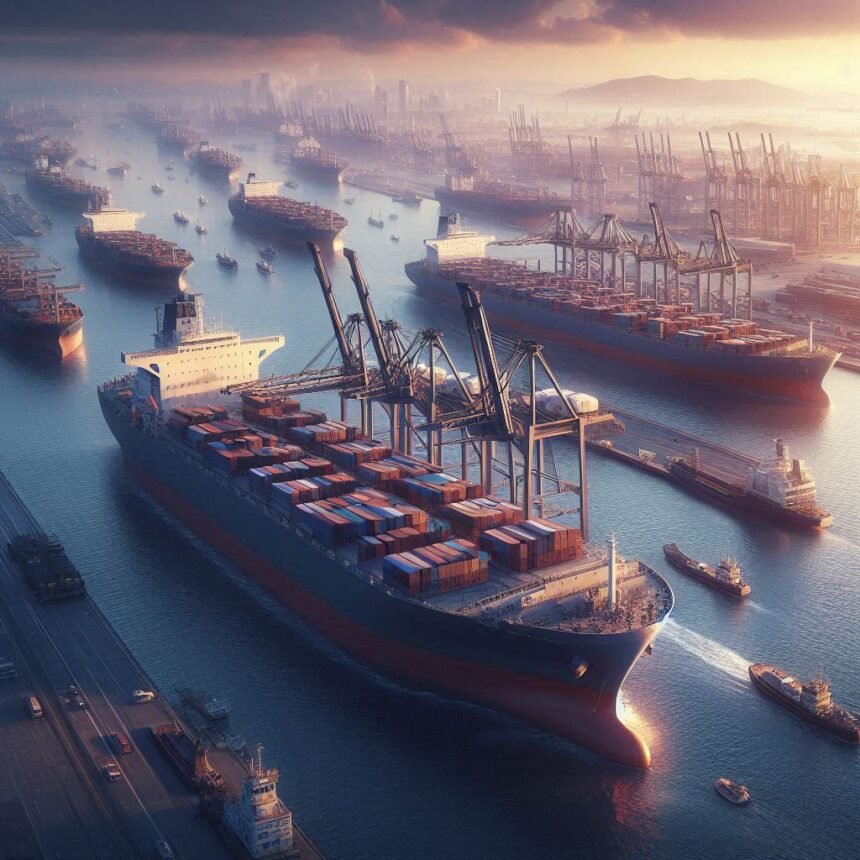General Average (GA) is a fundamental principle in maritime law that has played a pivotal role in shipping and logistics for centuries. Originating from ancient maritime practices, the concept of GA is based on the equitable distribution of losses incurred during sea voyages. Historically, this principle was established to ensure that all parties involved in a maritime expedition would proportionately share any losses resulting from voluntary sacrifices made to safeguard the vessel and its cargo during emergencies.
The roots of General Average can be traced back to the Rhodian Sea Law, a set of maritime regulations from around 800 BC. These early laws set the groundwork for the idea that during perilous situations at sea, any intentional jettison of cargo or damage to the ship for the common safety should be compensated by all stakeholders proportionally. This principle was later incorporated into the medieval maritime codes, such as the Laws of Oleron and the Hanseatic League’s Ordinances, and ultimately became enshrined in modern international maritime law.
In contemporary shipping and logistics, General Average serves as a critical mechanism to manage risks and distribute losses. It is invoked when a significant and voluntary sacrifice is made by the ship’s master, such as jettisoning part of the cargo, flooding the hold to extinguish a fire, or incurring extraordinary expenses during a rescue operation. The costs and losses incurred from these actions are then shared among all parties with a financial interest in the voyage, including the shipowner, cargo owners, and insurers.
By adhering to the General Average principle, maritime stakeholders can mitigate the financial impact of unforeseen emergencies. Marine cargo insurance policies often include a General Average clause, which stipulates that the insurer will cover the cargo owner’s share of any General Average contribution. This not only provides financial protection but also fosters a cooperative spirit among all parties involved in maritime commerce, ensuring that the collective interests are upheld during times of crisis.
Legal Framework and Principles of General Average
The legal framework governing General Average (GA) is primarily based on international conventions, most notably the York-Antwerp Rules. These rules provide a standardized set of guidelines to determine what constitutes GA and how it should be applied. The York-Antwerp Rules have been periodically updated, with the most recent revision occurring in 2016. These rules are not legally binding unless incorporated into a contract, but they are widely accepted and utilized in marine insurance policies and shipping contracts across the globe.
General Average is predicated on several core principles. The first is the principle of voluntary sacrifice, which necessitates that any loss or damage incurred must be intentional and for the common good. This means that the sacrifice must be made voluntarily by the ship’s master or crew to preserve the vessel and its cargo from a perilous situation. The second principle is imminent peril, which requires that the danger must be real and substantial, posing an immediate threat to the ship and its cargo. The third principle pertains to the preservation of property, stipulating that the voluntary sacrifice must aim to save the remaining property from destruction.
Maritime law plays a crucial role in the application and adjustment of General Average. When a GA event is declared, all parties involved in the maritime venture, including the shipowner, cargo owners, and insurers, are required to contribute proportionally to the losses incurred. This contribution is calculated based on the value of the property saved and the total value of the property at risk. The adjustment process is typically handled by an independent average adjuster, who assesses the losses and determines the contributions of each party.
To declare General Average, the ship’s master must present a detailed account of the incident, outlining the nature of the peril, the actions taken, and the losses incurred. This documentation is then reviewed by the average adjuster, who applies the York-Antwerp Rules to determine the validity of the claim and the appropriate contributions. The intricate process of GA declaration and adjustment underscores the importance of having a comprehensive marine insurance policy that includes a General Average clause, ensuring that all parties are adequately protected in the event of a maritime emergency.
Mechanics of Declaring General Average
The process of declaring General Average (GA) is a structured and meticulous procedure, involving several key players and specific documentation. The declaration typically begins with the shipowner, who, upon encountering a peril that necessitates a sacrifice or extraordinary expenditure to save the maritime venture, decides to declare GA. This decision must be made in good faith, ensuring that the actions taken are for the common good of the ship and its cargo.
 Once the decision is made, the shipowner informs the cargo owners and an average adjuster is appointed. The average adjuster, a specialist in maritime claims, plays a pivotal role in assessing and documenting the losses incurred. Their primary responsibility is to ensure that the sacrifices and expenditures are properly accounted for and that the contribution to the GA is equitably distributed among the parties involved.
Once the decision is made, the shipowner informs the cargo owners and an average adjuster is appointed. The average adjuster, a specialist in maritime claims, plays a pivotal role in assessing and documenting the losses incurred. Their primary responsibility is to ensure that the sacrifices and expenditures are properly accounted for and that the contribution to the GA is equitably distributed among the parties involved.
The first step in the documentation process is issuing a General Average bond and a General Average guarantee. The GA bond is a formal agreement signed by the cargo owners, committing to pay their share of the GA expenses. The GA guarantee, often provided by the cargo owner’s insurers, ensures that the shipowner will receive the necessary funds to cover the GA expenses. These documents are essential in assuring that the financial burden is distributed fairly and that the shipowner is not left to bear the costs alone.
Assessing and documenting losses involves a comprehensive survey of the damages and expenses. The average adjuster collaborates with surveyors to inspect the ship and cargo, collecting evidence and detailed reports on the nature of the losses. This data is crucial for calculating the contributions required from each party. The adjuster prepares a General Average statement, outlining the losses and the proportionate contributions of the cargo owners.
The timeline for declaring and settling GA can vary depending on the complexity of the incident and the thoroughness of the documentation. However, it generally involves prompt communication and coordination among all parties to ensure a timely resolution. Accurate and detailed documentation is critical, as it forms the basis for the adjuster’s calculations and the subsequent settlement of claims.
In conclusion, the mechanics of declaring General Average involve a collaborative effort between the shipowner, cargo owners, and the average adjuster. It requires meticulous documentation and a clear understanding of the roles and responsibilities of each party to ensure an equitable distribution of losses and expenses.
Impact of General Average on Marine Cargo Insurance
The declaration of General Average has significant implications for marine cargo insurance policies. When General Average is declared, it necessitates a shared financial responsibility among all parties involved in the maritime venture, including cargo owners and insurers. This principle ensures that losses incurred for the common good of the voyage are equitably distributed, thereby safeguarding the interests of all stakeholders.
In the event of a General Average, cargo owners are required to contribute towards the expenses and losses that benefit the entire voyage. This contribution is known as the General Average contribution. Marine cargo insurance policies typically include a General Average clause, which outlines the conditions under which the insurer will cover these contributions. The inclusion of this clause is crucial as it provides a safety net for cargo owners, ensuring that their financial burden is minimized in such events.
There are different types of coverage available under marine cargo insurance policies that address General Average. Firstly, the Standard Coverage includes the General Average clause, where the insurer agrees to indemnify the cargo owner for their share of the General Average contribution. Secondly, the All-Risk Coverage offers a more comprehensive protection, covering a wider range of perils including General Average events. It is essential for cargo owners to thoroughly review their policies to understand the extent of coverage provided for General Average contributions.
Potential scenarios where General Average claims might arise include incidents such as jettisoning cargo to refloat a stranded vessel, combating a fire onboard, or incurring costs to tow a vessel to safety. In these situations, the incurred expenses are deemed necessary for the preservation of the remaining cargo and the vessel. The General Average clause ensures that the financial impact of these extraordinary measures is distributed among all stakeholders, rather than being borne solely by the party that suffered the direct loss.
Understanding the impact of General Average on marine cargo insurance is essential for cargo owners and insurers alike. It highlights the importance of having comprehensive insurance coverage that includes provisions for General Average contributions, thereby ensuring financial protection and stability in maritime ventures.
Case Studies of General Average Incidents
General Average (GA) is a principle of maritime law wherein all stakeholders in a sea venture proportionally share any losses resulting from voluntary sacrifices of part of the ship or cargo to save the whole in an emergency. To better understand its practical implications, let us examine two significant General Average incidents: the MSC Napoli in 2007 and the Ever Given in 2021.

In January 2007, the container ship MSC Napoli encountered severe hull damage due to heavy weather in the English Channel. To prevent the vessel from sinking, the crew decided to intentionally ground the ship off the coast of Devon, England. This deliberate action was deemed necessary to save the ship, crew, and cargo, thereby invoking the General Average clause. As a result, cargo owners were required to contribute to the costs associated with salvaging the vessel and mitigating further losses. This incident highlighted the critical role of marine cargo insurance in safeguarding the interests of cargo owners against unforeseen maritime perils.
Another high-profile case involved the Ever Given, a massive container ship that blocked the Suez Canal in March 2021. The vessel ran aground during a sandstorm, obstructing one of the world’s most crucial maritime trade routes for six days. The blockage caused significant delays and financial losses for numerous shipping companies. To refloat the Ever Given, extensive efforts were undertaken, including the removal of cargo and ballast water, dredging, and the use of tugboats. The declaration of General Average meant that cargo owners had to share the costs incurred during the salvage operation. This incident underscored the complexities of marine insurance and the far-reaching impact of the General Average clause on global trade.
These cases illustrate how General Average can necessitate substantial financial contributions from cargo owners and insurers, emphasizing the importance of understanding its implications within marine cargo insurance. By examining the circumstances and outcomes of such incidents, stakeholders can better appreciate the necessity of marine insurance and the protective measures it affords in the face of maritime emergencies.
Calculating General Average Contributions
Calculating General Average contributions is a meticulous process overseen by an average adjuster, whose role is to ensure the equitable distribution of losses among all parties involved. The average adjuster meticulously reviews the circumstances of the marine casualty, assesses the value of the sacrificed cargo, and quantifies the value of the saved property. These assessments form the basis for apportioning the total loss among the stakeholders.
 The calculation begins with determining the value of the cargo that was intentionally sacrificed for the common safety. This value, along with the costs incurred during the General Average act, constitutes the General Average loss. Concurrently, the value of the saved property—be it cargo, vessel, or freight—is appraised. The combined value of the saved property and the General Average loss forms the contributory value, which is fundamental to the apportionment process.
The calculation begins with determining the value of the cargo that was intentionally sacrificed for the common safety. This value, along with the costs incurred during the General Average act, constitutes the General Average loss. Concurrently, the value of the saved property—be it cargo, vessel, or freight—is appraised. The combined value of the saved property and the General Average loss forms the contributory value, which is fundamental to the apportionment process.
The formula used to calculate each party’s contribution is straightforward yet comprehensive: the General Average loss is distributed among the stakeholders in proportion to the contributory value of their interest in the voyage. Mathematically, this can be expressed as:
Contribution of a stakeholder = (Value of their saved property / Total value of all saved property) x Total General Average loss
For clarity, consider a simplified example: Suppose a ship carrying cargo worth $1,000,000 experiences a General Average event, where $100,000 worth of cargo is sacrificed to save the vessel and remaining cargo. If the saved property is valued at $900,000, the total General Average loss of $100,000 is apportioned based on the value of the saved property. If a particular stakeholder’s cargo is valued at $100,000, their contribution would be calculated as follows:
Contribution = ($100,000 / $900,000) x $100,000 = $11,111
This example illustrates the proportional nature of General Average contributions, ensuring that each party bears a fair share of the loss commensurate with the value of their saved property. This systematic approach underscores the vital role of the average adjuster in maintaining equity and transparency within the realm of marine cargo insurance.
Challenges and Controversies in General Average
General Average (GA) is an established principle in marine insurance that demands equitable distribution of losses incurred for the common good. However, the application of the General Average clause is not without its challenges and controversies. One of the primary issues is the delay in settlement. The process of calculating and apportioning losses is inherently complex and time-consuming, often leading to significant delays. This not only disrupts the flow of commerce but also imposes additional financial burdens on cargo owners who must wait for compensation.
 Disputes over the valuation of sacrifices and expenditures are another common challenge. Determining the monetary value of jettisoned cargo or damage to the vessel demands meticulous assessment, which frequently leads to disagreements among stakeholders. Such disputes can escalate into protracted legal battles, further complicating the settlement process and exacerbating financial strains on involved parties.
Disputes over the valuation of sacrifices and expenditures are another common challenge. Determining the monetary value of jettisoned cargo or damage to the vessel demands meticulous assessment, which frequently leads to disagreements among stakeholders. Such disputes can escalate into protracted legal battles, further complicating the settlement process and exacerbating financial strains on involved parties.
The financial burden imposed on cargo owners under the General Average clause is another point of contention. While the principle promotes collective responsibility, the reality is that small and medium-sized enterprises (SMEs) may struggle to bear their share of the costs. This has led to criticisms that the GA system disproportionately affects smaller players in the maritime industry, potentially impacting their sustainability.
Recent trends indicate a growing scrutiny of the General Average system. Critics argue that the antiquated principles underpinning GA are ill-suited to modern maritime commerce, where technological advancements and global trade dynamics have transformed the industry. Calls for reform are gaining traction, with suggestions ranging from simplifying the calculation process to introducing alternative mechanisms such as insurance products specifically designed to cover GA-related risks.
Potential reforms to the current General Average system include the introduction of standardized valuation methods to minimize disputes and streamline settlements. Additionally, there is a push for greater transparency and efficiency in the apportionment process, potentially leveraging digital technologies to enhance accuracy and speed. These proposed reforms aim to mitigate the challenges and controversies associated with GA, ensuring it remains a viable tool for managing marine cargo insurance risks in the contemporary maritime landscape.
Conclusion: Future of General Average in Marine Insurance
Throughout this blog post, we have explored the intricate concept of General Average (GA) and its profound impact on marine cargo insurance. Understanding the General Average clause is crucial for cargo owners, shippers, and insurers alike, as it determines the equitable distribution of costs related to sacrifices and expenditures made for the common good during maritime voyages. This principle, deeply rooted in maritime law, ensures that all parties involved share the financial burden of losses incurred during an emergency.
The application of the General Average clause has significant implications for marine insurance. It influences the terms and conditions of policies, the assessment of premiums, and the settlement of claims. Case studies of the General Average clause in action have demonstrated its pivotal role in safeguarding the interests of stakeholders by promoting fairness and encouraging proactive risk management.
As maritime laws and shipping practices continue to evolve, the future of General Average in marine insurance will likely undergo significant transformations. Technological advancements, such as improved navigational systems and real-time monitoring, may reduce the frequency of GA incidents. However, the increasing complexity of global supply chains and the advent of mega-ships could introduce new risks, necessitating a nuanced understanding of GA principles.
 For stakeholders, staying informed and prepared for potential GA incidents is paramount. This entails not only a thorough comprehension of the General Average clause but also staying abreast of changes in maritime regulations and industry best practices. By doing so, cargo owners, shippers, and insurers can better navigate the challenges posed by GA situations, ensuring the continued efficiency and resilience of maritime commerce.
For stakeholders, staying informed and prepared for potential GA incidents is paramount. This entails not only a thorough comprehension of the General Average clause but also staying abreast of changes in maritime regulations and industry best practices. By doing so, cargo owners, shippers, and insurers can better navigate the challenges posed by GA situations, ensuring the continued efficiency and resilience of maritime commerce.
In conclusion, while the principles of General Average remain steadfast, its application will adapt to the changing landscape of marine insurance. Continuous education and vigilance will be key for all parties to effectively manage the risks and responsibilities associated with maritime ventures.










